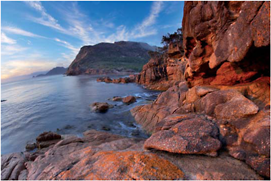
Hadrian’s Wall, Northumberland, England
Nothing beats a big panoramic. As yet, there’s no digital alternative. Image stitching? Fine if nothing is moving in the frame where the joins are made. Trouble is, something usually is, especially along Hadrian’s Wall; clouds, cows, Centurions, Picts …
• Fuji GX617, 90mm lens
Equipment
The importance of the equipment in photography is usually overestimated. Many people are more interested in the gear and technology than the actual images. To listen to some it’s as if the camera made the image, and the photographer merely leant support. Let’s just get a few things straight. A camera is but a tool, useless in the wrong hands. Give an experienced photographer the cheapest compact and a novice a top-of-the-range model and who will make the better pictures? A photograph stands on its own; its worth depends solely on the impression it makes on the viewer. The camera or lens that was used to create it is irrelevant. A photograph is made not by a camera but with a photographer’s vision and craftsmanship. Nevertheless the tools are important.
My cameras
I’ve used and owned many cameras of all formats over the years. I was wedded initially in the early 1980s to the Olympus OM system, which was delightfully compact with great lenses. When Olympus abandoned the professional market I switched to Nikon. For nine years my two Nikon F5s circled the world with me, never missing a beat. The F5 is in my view the best 35mm SLR film camera ever made and many of the images in this book were shot using one. A battered F5 body now sits on my desk as a memento alongside an OM1 from my student days. I think it highly unlikely I’ll ever use the same camera for nine years again.
A choice of formats
I’ve owned various medium-format systems – a Hassleblad was my workhorse for years of commercial work – but I never really gelled with the square format. All photographers are different, and there’s no right and wrong here; we use the systems that best suit our approaches. For me that’s been a combination of the 6x17cm panoramic format and 35mm. I find the two offset each other well. The panoramic format delivers incredible quality and allows a unique view on the world, particularly for landscape work. With 90mm and 180mm lenses, it’s a rugged, simple

Buttermere, Cumbria, Lake District, England
Perfect reflections on Buttermere, shot with the Canon EOS-1Ds MKII with a 70–200mm f/2.8 lens with Image Stabilization. In the early days I used to lust after optics such as this lens in the mistaken belief that their possession would improve my photography. It doesn’t. No equipment does.
• Canon EOS-1Ds MKII, 70–200mm lens
and relatively portable system, but not exactly compact. And 35mm has provided the flexibility and spontaneity, with the ultimate choice of lenses. The 5x4in large format is not for me; it delivers impressive quality but at the price of flexibility, but I respect my photo-mates who make this format work for them. A photographer’s choice of format will be inextricably linked with their vision and way of working, and, ultimately, it’s the pictures that matter.
The digital switch-over
Now it’s all change with the switch to digital capture. I still use the big panoramic film camera, as there’s no digital alternative for that yet, but the 35mm Nikons have been replaced with digital Canons. I defected from Nikon to Canon because of the fundamentally important issue of sensor size and now I’ve got an extensive system built around two Canon EOS-1Ds MKII bodies with lenses ranging from the 15mm fisheye to 400mm.
The set-up back in the digital darkroom is just as important. Time was when I thought we were high-tech with just a fax machine; now we’ve an

Dawn at Sleepy Bay, Freycinet Peninsula,
Freycinet National Park, Tasmania
The beauty of working on 35mm, and now with a full-frame DSLR, is the option of using lenses of extreme focal length. Here in Tasmania, a 15mm fisheye gives a 180-degree view of Sleepy Bay, without getting the tripod legs in shot.
• Canon EOS-1Ds MKII, 15mm fisheye lens
office stuffed with computers, monitors, scanners, printers … and a kettle. A lot of people get worked up about the Mac v PC debate; personally I don’t believe it makes much difference. We use PCs, three of them plus a laptop, with loads of RAM for handling large images. What are of crucial importance are the monitors – you have to be able to trust what you’re looking at, so they have to be colour calibrated. My advice is to ignore the techno-babble, and just go for the best monitor you can afford with a dedicated colour calibration system. All our PCs are networked and each has two monitors, one LaCie for the critical colour work and a smaller one for the tools tablets when working in Photoshop. Also in constant use is our Imacon 646 for scanning big transparencies. And being able to produce professional art prints now with the Epson 2100 is such a rewarding kick. Somewhat less exciting is the constant necessity of backing up images, both RAW and processed. For that we use a combination of dedicated hard drives and two DVD libraries, one stored remotely. Other vital bits? Well, a graphics tablet is handy … as is a packet of ginger biscuits.
